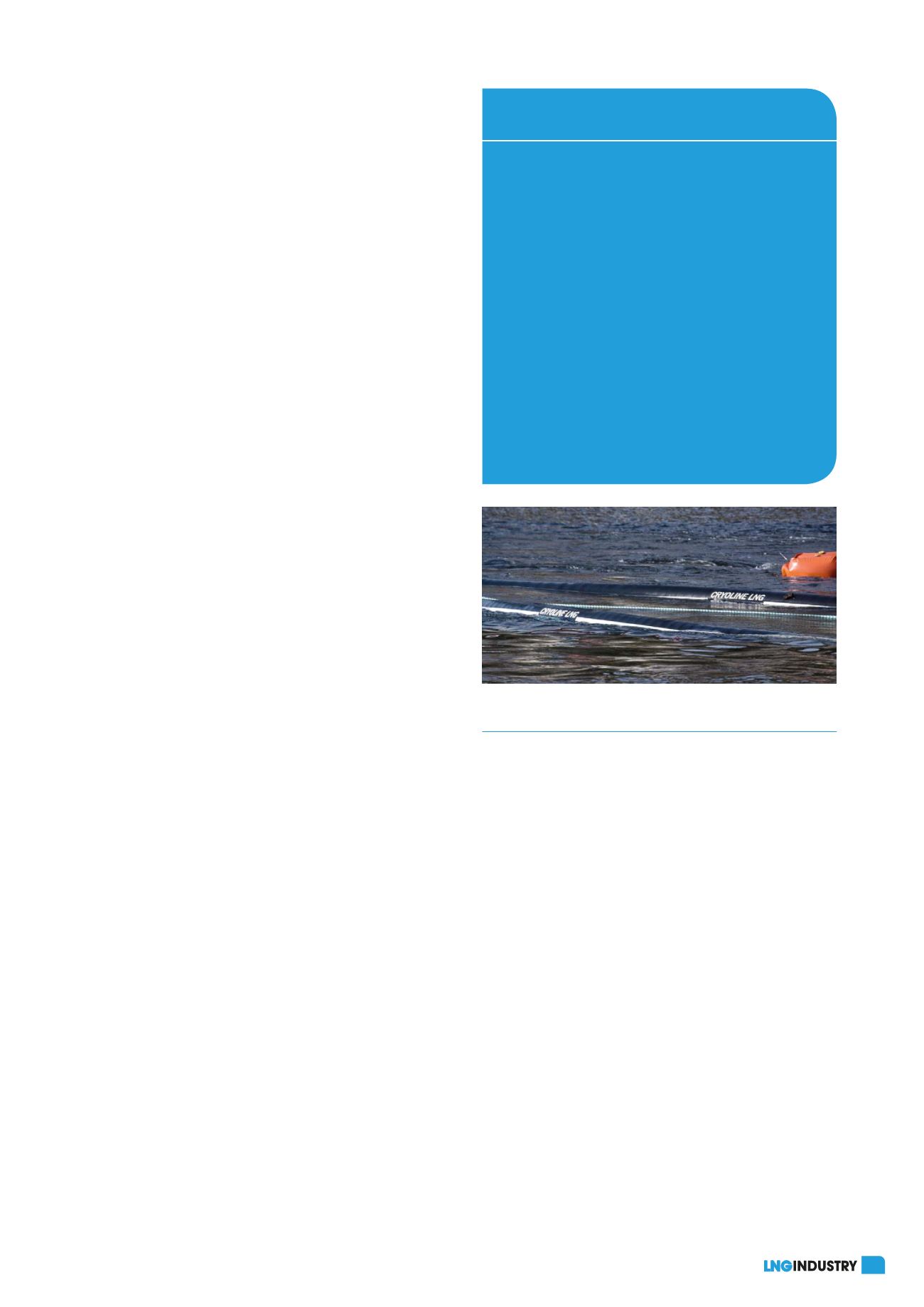
January 2020
31
cost reductions, flexibility and simplicity. Today, the UTS
remains the only existing and field proven solution for
LNG transfer utilising floating flexible hoses and a
vacuum attachment system for mooring to LNG carriers.
The initial challenge in the development of
small scale LNG is the difficulty in designing the
appropriate scale of each facility in the small scale LNG
value chain. LNG-related facilities have economies of
scale and so it is necessary to capture a broader end-user
group, as well as ensuring a diversified demand and
optimal ROI. This is particularly true in developing
economies, where demand logistics are not always fully
defined and there is insufficient data to fully assess and
forecast energy demand and its potential growth. To
alleviate this challenge, the UTS has flexibility inherently
designed into the system, which means that the platform
and supporting structures can be designed for maximum
demand, while investment for the service lines (aerial
hoses, floating cryogenic hoses, emergency release
systems, etc.) is not required until there is a clear market
overview and supplier-demand contracts are in place.
LNG as a bunkering fuel
There have been several rounds of increasingly
stringent environmental regulations being applied to
the Emission Control Areas (ECAs) of Northern Europe
and North America under the International Maritime
Organization (IMO). As of 1 January 2020, the IMO has
enforced a reduction of sulfur in ships’ fuel oil from 3.5%
to 0.5%.
One of the options for ship owners/operators is to
switch to LNG as a shipping fuel, either by retrofitting
their existing vessels, or by purchasing new,
purpose-built, LNG-fuelled vessels. The need to build
associated infrastructures to feed these ships goes hand
in hand. Since bunkering plays an essential role for each
voyage, this will have implications on the availability of
LNG as a bunkering fuel, hence LNG infrastructure along
the shipping route. Already in Europe, many ports are
working towards the adaptation of their assets to
accommodate such LNG facilities: large scale LNG
terminals are obligated to adapt to markets and have
flexible capacities to meet different demands if they are
to remain attractive. Offering bunkering through simple
integration of jettyless solutions in an existing LNG
infrastructure opens up new markets and generates
additional revenue streams.
The following describes two cases which study how
floating jettyless technology will enable businesses to
capture new markets and ensure access to cleaner energy,
thus responding to the call for climate awareness and
positive action.
Case A – small scale LNG for
energy infrastructure
Case A looks to solve the complexities of small scale
LNG supply via large scale LNG terminals, whereby LNG
from an existing large scale terminal is reloaded onto
small scale LNG carriers and shipped to small scale LNG
receiving terminals to be regasified and used as gas-fired
power generation. The terminal facility for Case A has
existing jetties and onshore cryogenic pipelines, with an
LNG capacity of up to 7 million tpy. As this is an active
terminal, there must be limited interference with ongoing
operations with other vessels.
Requirements and design criteria
The key in designing a site specific UTS is to design for
adequate uptime based on the operational requirements
and environmental parameters. To start with, site location,
metocean data, LNG transfer rate and distance between
beachline and LNG carrier mooring location are analysed.
From there, a high-level feasibility evaluation is executed
in order to identify any technical/operational risks,
which is particularly relevant when there is existing
infrastructure.
The UTS design and engineering work is carried out in
accordance with CSN EN 1474 ‘Installation and Equipment
for Liquefied Natural Gas’ and relevant OCIMF and SIGTTO
guidelines. In addition to this, all subsystems are designed
according to relevant rules, regulations and guidelines,
especially from a regional perspective relating to statutory
regulations for terminal projects.
A critical element to the entire system integrity and
resultant success of any marine project is to predict the
uptime for the facility, which will be defined by the
Innovation highlight: UTS
floating cryogenic hoses
Floating cryogenic LNG hoses enable safe transfer of LNG
from the existing terminal to small scale LNG carriers.
This technology has enabled floating LNG transfer.
z
Dedicated hose in hose design.
z
Integrated monitoring system allows for continuous
surveying of the transfer line from the control room.
z
Operating pressure up to 20 bar.
z
Diameter from 150 mm (6 in.) to 500 mm (20 in.).
z
Certified by DNV GL and Bureau Veritas.
Objectives:
z
Ensure LNG transfer with minimum BOG generation.
z
Meet LNG offloading requirements versus safety,
flowrate and availability.
z
Combine high flexibility, reliability and long service
life.
Figure 3.
Connect LNG’s UTS for jettyless transfer of LNG
and other fluids.








